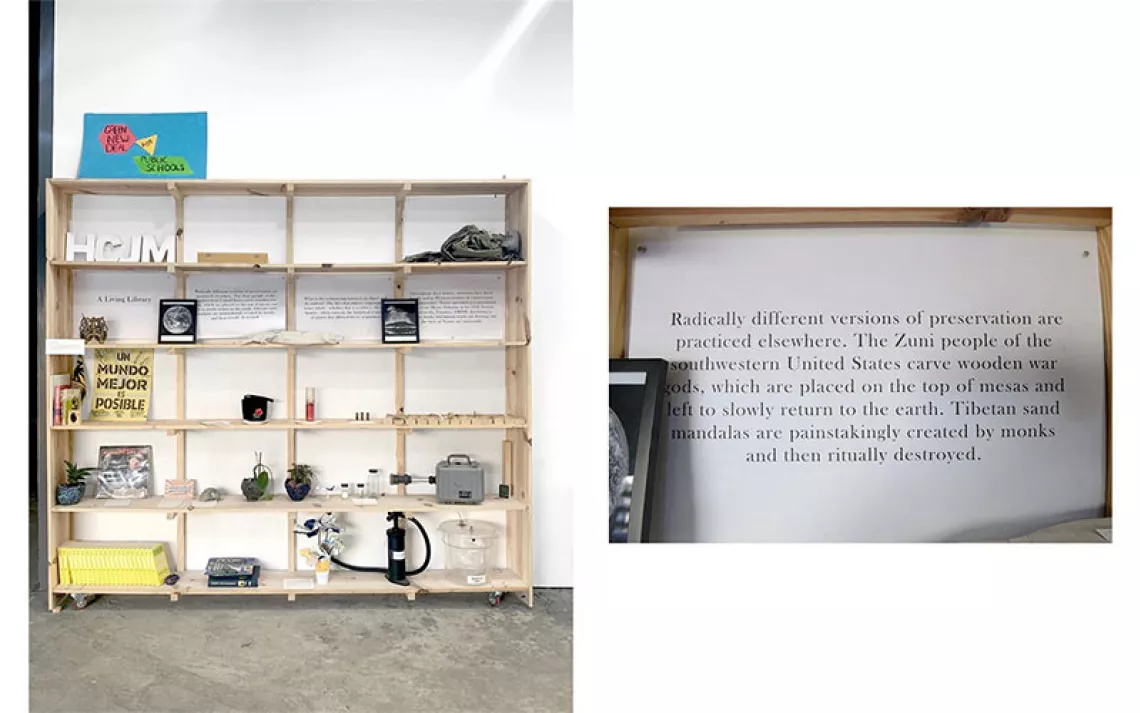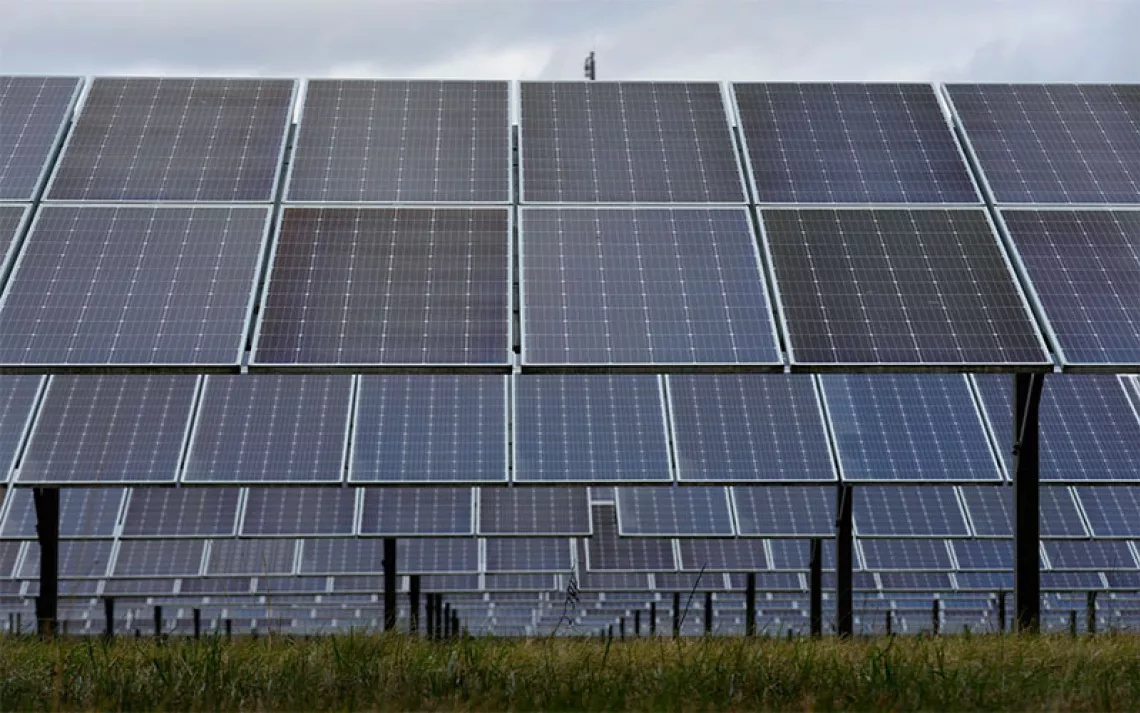How Clean Is "Clean Hydrogen"?
Black and brown communities are asked to bear the risks of the new energy economy. As usual.
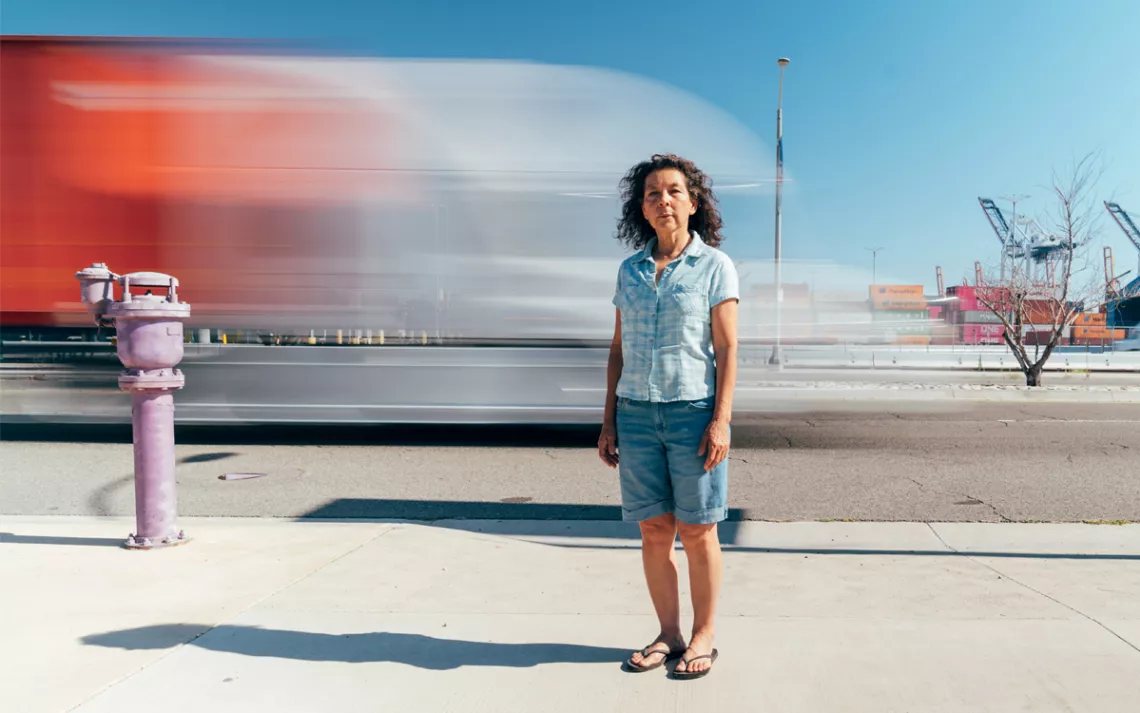
Alicia Rivera, an organizer with Communities for a Better Environment, in Wilmington, California, says that hydrogen is "just going to be a different kind of risk."
IN JUNE 2021, the Biden administration unveiled the first of its "Energy Earthshots," echoing President John F. Kennedy's famous "Moon Shot" speech from 60 years earlier. Instead of winning the space race, Biden's goal is to avert climate chaos by developing "more abundant, affordable, and reliable clean energy solutions within the decade." Today, thanks to billions of dollars in clean energy tax incentives and other funding from the Infrastructure Investment and Jobs Act and the Inflation Reduction Act, hydrogen, the most common element in the universe, is being fast-tracked as a means to resolve our fossil fuel dependence.
In the lead-up to the 1969 Apollo 11 takeoff, hundreds of people gathered outside the Kennedy Space Center to protest the cost of the Moon Shot as Black families struggled to survive. The protest included several mule-drawn carts, recalling the promise—never fulfilled—made to the formerly enslaved of "40 acres and a mule." Now, as Los Angeles vies to become one of a handful of US "hydrogen hubs," energy-democracy and environmental-justice advocates insist on an equitable outcome for the Black and Latino communities. A win would ensure that a just transition from the fossil fuel economy in places like South LA comes with the environmental, safety, and financial guardrails that any nascent technology requires.
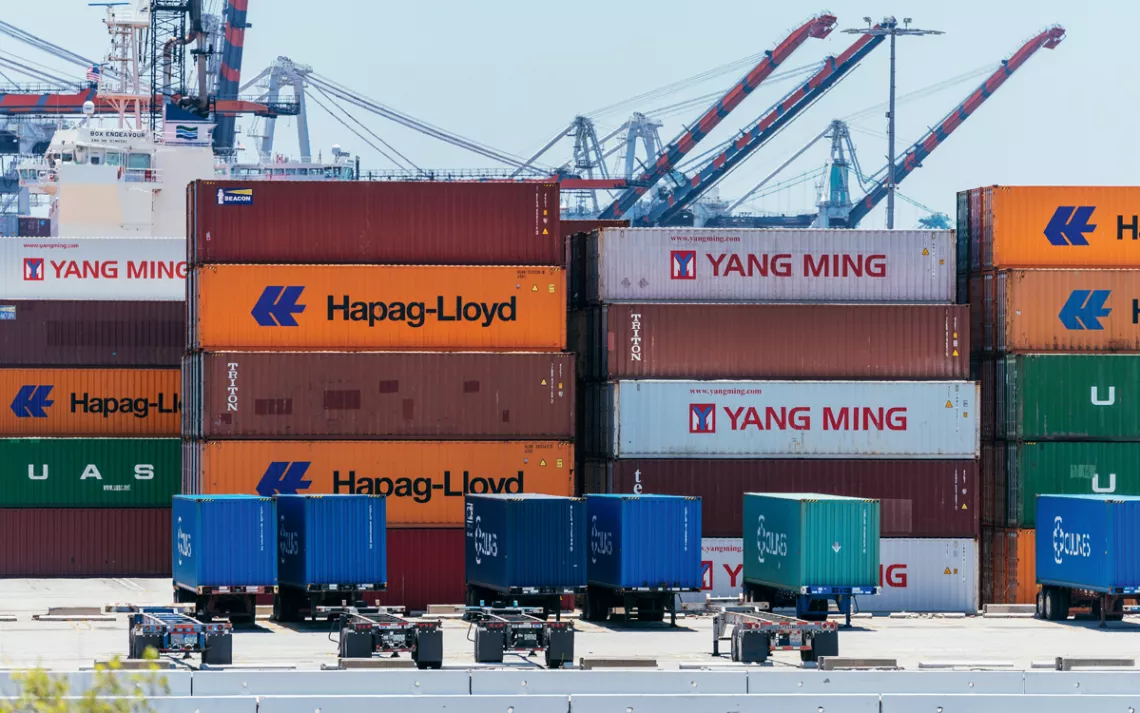
Cargo-handling equipment at the bustling Port of Los Angeles could soon be powered by hydrogen fuel cells.
Energy justice is at risk in the hydrogen rush, though. Among hydrogen's strongest advocates are methane-gas utilities seeking to leverage federal dollars to preserve their businesses as cities phase out gas and expand solar, wind, and battery storage. The Los Angeles Department of Water and Power (LADWP), the nation's largest municipal utility, and SoCalGas, the largest methane-gas distribution utility, are betting on hydrogen. LA has committed to drastically reducing its CO2 emissions to achieve a 100 percent renewable power grid by 2035. Hydrogen has become central to the vision of how to get there.
LA, however, still runs on fossil fuels. One-third of LA County residents live within a mile of an oil-drilling site. And it still has fossil fuel sacrifice zones, including communities like Wilmington in South LA. It's no wonder that people there are skeptical about how clean "clean hydrogen" really is.
A FEW DAYS before I visited Wilmington in May, a gas leak at its Marathon Petroleum refinery sent four workers to the hospital, one in critical condition. TikTok's @wilmington_chronicles included a face-palm emoji with the comment "this is e'ryday in wilmas!!" City census tracts rank in the 97th percentile for "disadvantaged community" indicators like cancer risk, income, and exposure to the types of airborne particulate matter associated with asthma, heart disease, and premature death. Wilmington helps power the nation, but it suffers frequent power outages.
A SoCalGas lobbyist admitted that Scattergood's hydrogen retrofit ensured that methane would keep flowing into the LA Basin for the foreseeable future.
At Wilmington's Waterfront Park—a well-manicured open space with soccer fields, jogging paths, a playground, and native landscaping—I met Alicia Rivera, an organizer for the environmental-justice organization Communities for a Better Environment. A new Wilmington Waterfront Promenade will soon connect the city with its historic waterfront. This $71 million gift to the community from the Port of Los Angeles came after the initial bid to simply build a buffer wall between the port and the neighborhood was flatly rejected by residents.
The bustling port operates 24/7 and is the western hemisphere's busiest. Massive cargo ships and acres of stacked multicolored containers waited to be picked up and moved by container freight handlers, each of which emits hundreds of tons of carbon dioxide a year. Chris Cannon, the port's chief sustainability officer, told me that the cargo-handling equipment might be a good candidate for hydrogen-powered fuel cells. "We are certainly going to need clean hydrogen at the port for the operation of heavy equipment. And we think eventually the ships may start to use hydrogen as well," he said.

The port is a major polluter of neighboring Wilmington.
On Harry Bridges Boulevard, named for the radical labor leader, heavy-duty diesel trucks moved in and out of the docks. To the west, emissions from the Phillips 66 oil refinery formed a horizontal plume that blended in with gathering storm clouds. I asked Rivera about the rotten-egg smell. She said that it was hydrogen sulfide, produced by oil refining, but she was so used to it that she couldn't smell it anymore. The Occupational Safety and Health Administration refers to this phenomenon as "olfactory fatigue," which can be deadly if you can't smell a leak, like the one at the Marathon refinery earlier in the week.
Rivera is a grandmother of two who still carries the accent of El Salvador, the country she fled during its civil war in the 1980s. She shifted easily between pointing out and naming the flowering ground cover around us to explaining why she's worried about bringing hydrogen production and use to Wilmington. "If we're switching into clean hydrogen at the refinery and the port, this community is not going to be better at all," she said. "It's just gonna be a different kind of risk."
DIRTY HYDROGEN IS already in wide use in Wilmington and around the world, mainly in oil refining, chemical sectors like fertilizer manufacturing, and steel production. Since hydrogen doesn't exist freely in nature, it needs to be produced from other energy sources. When that happens, it becomes an energy carrier like gasoline and can be stored and delivered when needed. Upwards of 95 percent of hydrogen is produced from methane (known as gray hydrogen) or from coal (brown hydrogen). Fossil fuels provide both the feedstock and the power for the energy-intensive process. Dirty hydrogen production accounts for 6 percent of global methane gas use and 2 percent of coal use, with massive carbon dioxide emissions as a byproduct.
"It sounds like they're doing the wrong thing for the right reason and using us as the guinea pigs."
A boutique variety, blue hydrogen, is produced from methane gas or biofuels and is powered that way as well, but its carbon emissions are captured and stored underground. At present, only about 40 commercial carbon capture and storage facilities of any sort exist in the world. A 2021 peer-reviewed article in Energy Science & Engineering found that the life-cycle greenhouse gas emissions of blue hydrogen were more than 20 percent greater than those from burning straight methane gas. "The use of blue hydrogen," the authors concluded, "appears difficult to justify on climate grounds."
Rivera expressed her own reservations in an analogy drawn from all the tire recycling and disposal shops in the neighborhood: "It's like if I had a bunch of tires and I was burning them in my backyard. If I put carbon capture in, it just means I can burn more tires." She also wondered where the carbon would be stored, and where the hydrogen pipelines would even go, given that the ground beneath us was already crammed with oil and gas infrastructure. She showed me signs—all in English, in a community that's over 85 percent Latino—with a number to call before excavating or in an emergency.
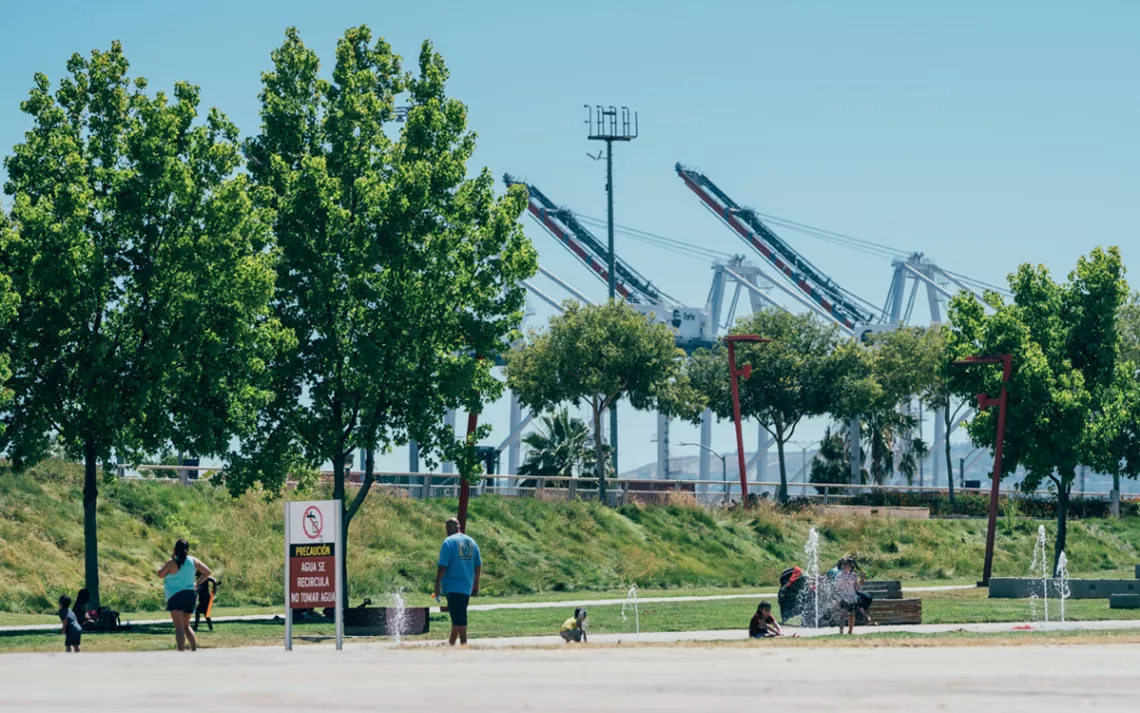
The heavily Latino community of Wilmington is considered disadvantaged by nearly every metric, but through organizing, it won the buffer of a new waterfront park between the neighborhood and the port.
Rarer even than blue hydrogen is green hydrogen, which uses wind, solar, or geothermal power in a process called electrolysis to split water molecules into hydrogen and oxygen. (It's not a new idea: You can read about it in Jules Verne's The Mysterious Island, published in 1874.) Green hydrogen is viewed by some environmentalists as a potential fix for hard-to-electrify industries—like oil, steel, cement, and chemical—that already use dirty hydrogen.
But green hydrogen has its drawbacks. It is extremely expensive to produce, mostly because electrolysis is a ridiculously energy-intensive process. According to a 2021 article on carbon-neutral steel in The New Yorker, creating enough green hydrogen to make just one ton of steel requires as much electricity as it takes to power an American home for three months. Just to replace the current use of gray hydrogen with green would take more than five times the amount of wind, solar, and geothermal power that the United States produced all last year.
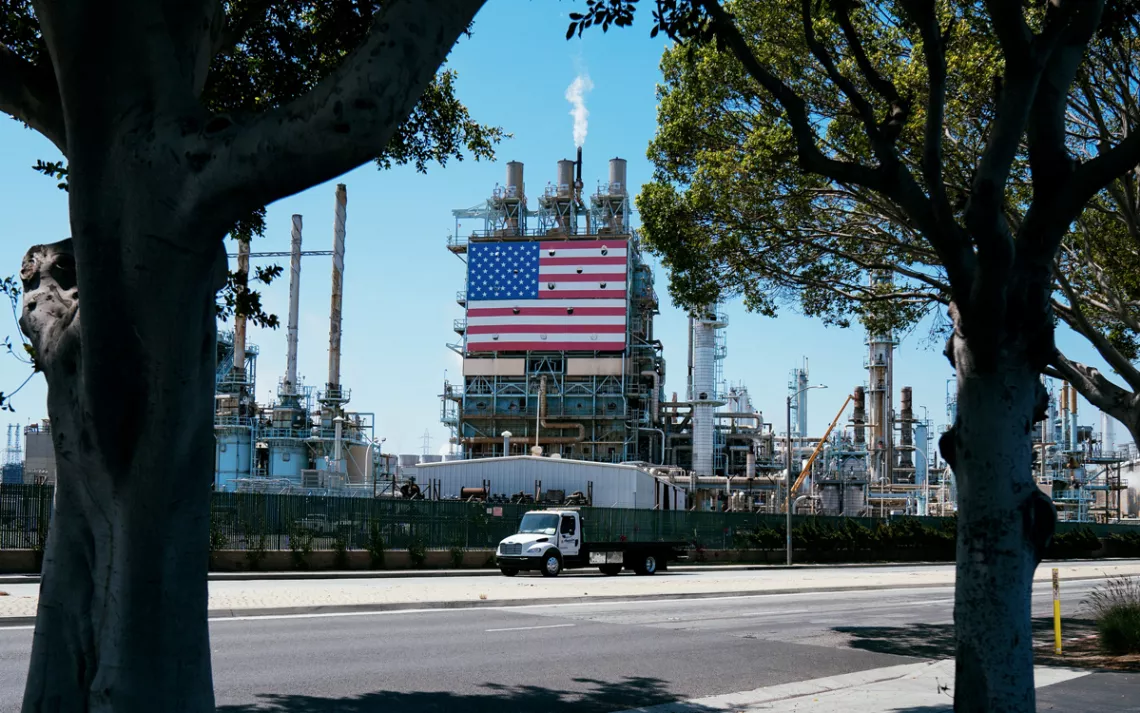
There's no protection from the neighboring Marathon refinery, where a gas leak in May sent four workers to the hospital.
And all forms of hydrogen suffer from the same elemental problems. Hydrogen carries one quarter the energy per unit volume of methane gas, meaning it requires a lot more hydrogen to get the same amount of power as using methane. Molecules of hydrogen are teeny—eight times smaller than methane molecules—making transport and storage prone to leaks. While hydrogen is not itself a greenhouse gas, when it escapes into the atmosphere, it can extend the life and intensity of methane, which is one. Hydrogen is also exceedingly flammable, so leaks are no joke. And since remote hydrogen-sensor technology is not commercially viable, leaks are hard to detect.
Pure hydrogen can't be safely transported through existing metal gas pipelines because it degrades and embrittles the steel, making it more prone to leaks. To enable pipeline transport, hydrogen is commonly blended with gas. But according to a 2022 study by the California Public Utility Commission, only blends of no more than 5 percent hydrogen are safe, which means that a whole lot of methane gas will continue to flow. For hydrogen to be burned at existing gas power plants, current technology can handle only blends of 20 to 40 percent hydrogen. When combusted, hydrogen produces toxic nitrogen oxides, which can damage respiratory airways and are already a health hazard, disproportionately in communities of color.
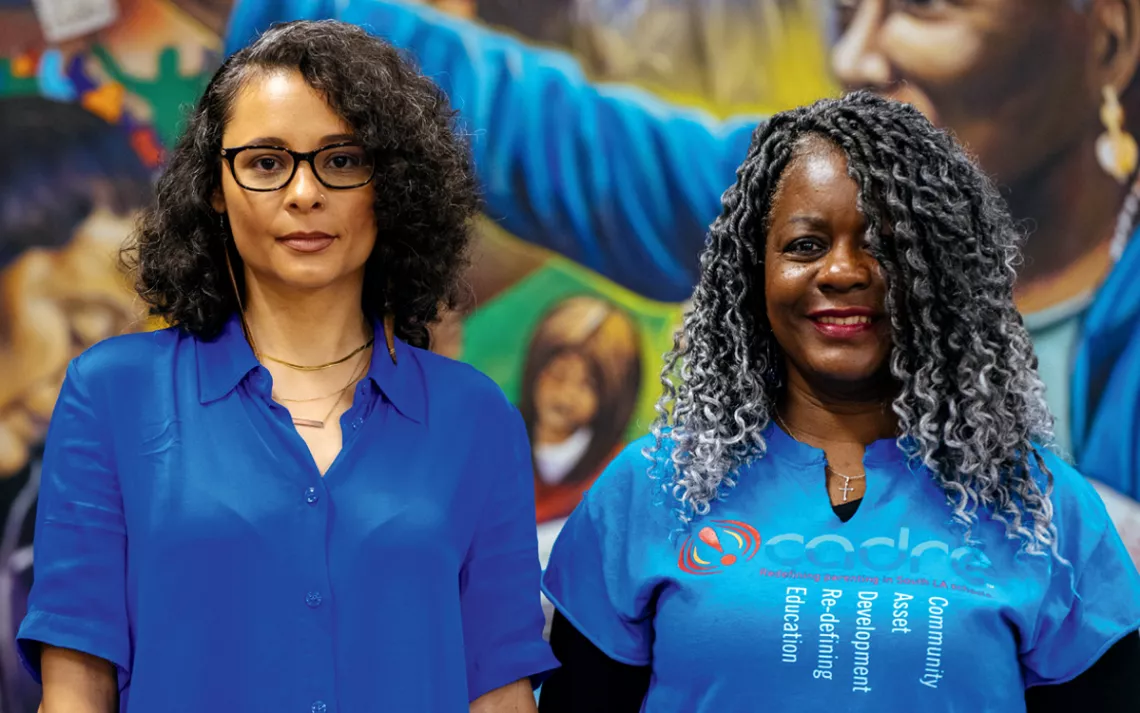
Èlice Hennessee (left) and Roslyn Broadnax, with South LA's CADRE, an organization devoted to generating genuine community engagement.
The federal government considers both green and blue hydrogen to be clean, and it's their production and use that the Biden administration and utility boosters are attempting to turbocharge in order to bring down their cost. The Sierra Club resists conflating "clean" with "green." According to Monica Embrey, until recently the LA-based West Coast energy campaign director, the Sierra Club takes a "hard no" position on blue hydrogen: "No steam methane reform with carbon capture and storage, no biomass or biogas." She added that the organization supports only the limited use of green electrolytic hydrogen in sectors that already use its dirty cousins and then only under strict conditions. For example, any green hydrogen project should draw on new renewable power that's nearby—otherwise, increased fossil fuel generation would cover the gap. Use of the renewable power should also occur at the same time it is produced, because otherwise, again, fossil fuel power would fill any gaps. "Our policy is very specific," Embrey said. "Use wind and solar, and count every molecule as to where and when it's used."
LOS ANGELES'S FIXATION on hydrogen began in 2016, when the LA City Council directed LADWP to figure out how to generate 100 percent of the city's energy from renewable sources. "LA was on the front lines of an amazing journey with that vote, doing something that nobody had ever done before," said Evan Gillespie, then a representative for the Sierra Club's Beyond Coal campaign. "It was really exciting."
At the time, half of LA's power came from fossil fuels and hydrogen was not even on the table. Gillespie remembered an early meeting with LADWP engineers in the department's Power Systems Room shortly after the council motion passed: "Written on the whiteboard under 'next steps,' there's only one, and it just says 'Watch Apollo 13.'" For those who don't remember, the movie is about NASA's quest to get back to the moon. There's a crisis, the astronauts have to abort the mission, everyone almost dies, but engineers save the day. It was LADWP's jokey way of being inspirational, Gillespie said. "They saw the significance of what they were trying to accomplish."
The utility commissioned the Department of Energy's National Renewable Energy Laboratory (NREL) to conduct what came to be known as the LA100 study. The effort included an advisory group of local stakeholders from city government, the school district, labor unions, neighborhood councils, energy players like SoCalGas, local businesses, and environmental groups. All met over the course of four years to get educated about infrastructure challenges, grapple with the data as it became available, compare costs and feasibility, and provide feedback on options as presented by the utility and the lab. Jaquelin Cochran was the NREL study's principal investigator. "Our role was to give the advisory group the information they needed," she said.
As time went by, environmental-justice representation declined as people grew frustrated by the lack of attention paid to their issues. Jasmin Vargas, then an organizer with Food & Water Watch, stuck it out over the course of four years and 30 meetings. Her concern was whether LA's clean energy transition was "going to benefit [our] community, be equitable and not leave anybody behind, and right some of those historic wrongs around environmental racism." But she understood why other folks stopped showing up. "In terms of priorities, they saw the system as rigged already. So it was a strategic question of, 'Are we gonna waste our time with these people?'" Vargas said. "I mean, we were dealing with people who had caused the problem in the first place!"
Luis Amezcua, at the time a Sierra Club senior campaign representative with a background in transmission and grid planning, was also a member of the advisory group. He agreed that issues like replacing outdated infrastructure were deprioritized. "The grid is a really important component of how LA is going to achieve its clean energy goals," he said, but "LA's grid is really old, especially in low-income areas." Energy-justice groups argued that because their communities have been neglected and suffered the most from the fossil fuel energy system, they should be first in line for an upgrade.
Amezcua noted that throughout the modeling process, estimates for how many households in low-income communities would adopt solar were low. "We tried to talk it through" with NREL and utility representatives, he said. "If it's 30 percent, shouldn't you have a goal to increase that to 50, 60, 70 percent?" It became clear that LADWP was concerned that if the utility put rooftop solar in an area with aging power lines, it would overload the whole system. Even so, he said, "We're sort of assuming that this stuff will never be taken care of."
Though hydrogen was introduced as a possible option in early presentations to the advisory group, it wasn't until the last meetings in May 2020 that it was seriously discussed as the way to reach the 100 percent renewable energy goal. At the time, LADWP general manager Marty Adams was on the advisory committee of the Green Hydrogen Coalition, a nonprofit with a goal to "create the first scaled ecosystem for green hydrogen in North America" starting with LA. (LADWP and SoCalGas are still among the coalition's leading donors.) When I spoke to Green Hydrogen Coalition founder and president Janice Lin, she told me that she and Adams had spent a lot of time together discussing hydrogen. (Adams did not respond to a request for comment on his involvement with the coalition.)
The NREL told the LA100 advisory group that the city of Los Angeles could get to 80 to 90 percent renewable power, but that to get to 100 percent, a storable fuel such as hydrogen could fill the gap—"the last mile" when extra power would be needed during peak usage. NREL presenters proposed to the group that LADWP retrofit one of the four gas power plants in the metro area to be "hydrogen ready" (meaning that the hydrogen would still be blended with methane) and able to combust 100 percent hydrogen by 2035. At the time, all four LADWP gas plants were slated for decommissioning, but after intense lobbying by the utility, the city council approved an $800 million retrofit for the Scattergood gas plant.
Amezcua supported limited use of green hydrogen, with caveats. "We need to be cautious but also understand that this was going to take some time to be implemented, so there were going to be opportunities to weigh in," he said. "And if the technology develops, or doesn't, we can change course."
While no combustion turbines commercially available today can burn 100 percent hydrogen, the advisory group operated under the assumption that they would be able to by 2035. "We were also assuming 100 percent green hydrogen," Cochran said.
SoCalGas was not. In a moment of candor at a 2021 meeting with LA City Council member Paul Koretz, a SoCalGas lobbyist admitted that Scattergood's hydrogen retrofit ensured that methane would keep flowing into the LA Basin for the foreseeable future.
The utility is now proposing that some of its other gas plants be retrofitted for hydrogen as well. In retrospect, Amezcua said he felt that LADWP "got an inch, and then they took a mile."
WHEN LA100 PUBLISHED its study in March 2021—with green hydrogen a leading option in all scenarios, and failing to substantively address environmental-justice concerns and solutions—it did so in a world shaken by the murder of George Floyd and the health disparities made glaringly apparent by the Covid pandemic. In what appeared to be an afterthought, several months after the LA100 study was published, a two-year "Equity Strategies" study was announced.
Èlice Hennessee is a co-executive director of strategy and sustainability at Community Asset Development Redefining Education (CADRE), a parent-focused organization, who participated in several Equity Strategies meetings. At the first one, she said, she and a dozen local Latino and Black leaders conveyed their communities' needs and concerns: What remediation efforts did LADWP plan for the harmful legacy energy infrastructure in their neighborhoods, like the disproportionate concentration of high-tension power lines and polluting power plants? How would community members benefit from going solar? Would there be affordable financing even if credit scores were low? What about weatherization?
At the following meeting, they were shown a PowerPoint presentation ostensibly including their "community generated" strategies and concerns, but none of these issues were addressed, causing increasing frustration. "The audacity of you asking me to provide input, yet there is still no discussion on how to improve our communities in the ways we have been advocating for," Hennessee said. "It felt like they already had a fully baked plan before they came to the table, like there was never a real desire for input. It was simply just to check off the box and say that we talked to them, and then move forward how they intended to move forward in any case." The meeting broke up, rancorously, after less than an hour.
Speaking with me later via Zoom, Hennessee wanted me to understand how authentic community engagement and successful advocacy happens. For starters, she said, you need to recognize community members as "solution drivers and changemakers." She introduced Roslyn Broadnax, a parent leader from CADRE who'd noticed that a lot of Black and brown students were getting suspended from school for "willful defiance." Concerned parents surveyed schools and found that the problem was widespread but that a definition of "willful defiance" was nonexistent. Broadnax said that when they went before the school board, "We were not trying to change their minds on why they suspended these kids. We were trying to change the system on not allowing this to happen again." They won.
Broadnax listened as Hennessee and I discussed the Equity Strategies meeting, the legacy of pollution in low-income communities, and the climate crisis. Then the topic turned to LADWP's effort to include hydrogen in the city's clean energy and climate-change-mitigation mix. "It sounds like they're doing the wrong thing for the right reason and using us as the guinea pigs," Broadnax said.
In 2020, the Green Hydrogen Coalition launched HyBuild Los Angeles, an initiative to create a "green hydrogen ecosystem." In a report detailing HyBuild Los Angeles's progress to date—including LADWP's commitment to be its first major hydrogen customer—the report's authors noted that "many community groups are experiencing lack of bandwidth to engage fully in [green hydrogen–] related processes," which, if not addressed, would "prevent various community stakeholders from participating in the fast-moving green hydrogen and energy infrastructure development processes." Lin seemed sincerely concerned about this when we spoke. "We do not want to re-create the systemic injustices that have existed in our fossil fuel ecosystem since the dawn of time," she said. "It's a rare opportunity to work in partnership with communities."
Yet the report also underscored that to achieve effective delivery, clean-hydrogen production plants and attendant pipelines must be "located as close as possible to trucking routes [and] ports," which largely coincide with low-income communities like Wilmington. How does this square with the Green Hydrogen Coalition's equity goals? "I would say this is an open question and one that's best posed to the communities themselves, because today they're dealing with diesel trucks spewing pollution, right?" Lin responded. "I would say there is no perfect solution for an energy system, but unless communities are part of the planning in the beginning and part of the decision-making, their needs won't be considered."
The "lack of bandwidth" by frontline communities that the Green Hydrogen Coalition laments is something that the City of Los Angeles is trying to address with its own operational model of community engagement. When a long-lasting heat dome settled over most of California in fall 2022, bringing scorching temperatures and nearly breaking the state's power grid, Marta Segura realized it was game time. She was not only the founding director of LA's Climate Emergency Mobilization Office but also the city's first-ever chief heat officer. She and her sole colleague tried to weather the crisis without losing sight of LA's low-income communities. Segura created multilingual heat-safety social media campaigns and an app that locates nearby cooling centers and hydration stations. She also worked on the ongoing "Climate Equity LA" webinar series, which brought together policy people and community members to co-create climate solutions and heat-mitigation proposals. The difference between these gatherings and the Equity Strategies sessions was stark. For example, the first webinars focused on how to equitably decarbonize buildings, a transition that will require expensive weatherization, new appliances, and infrastructure retrofits. A subsequent report warned of potential renter displacement during the retrofits and cautioned that accessible financing for low- and middle-income homeowners would be essential. The report, combined with on-the-ground activism, resulted in the LA City Council amending the decarbonization mandate to apply only to new buildings until the problems surfaced in Segura's community-engagement process were resolved.
I asked Segura if she felt a tension between slowing down the process of climate mitigation—to work at the pace of trust, as one environmental-justice advocate put it—and the immensity and immediacy of the climate change threat.
"Absolutely," she replied. "I feel the tension almost daily. But we've learned that when we go too fast, it also doesn't work. We find out after the laws have passed and the investments have been made that it's not having the intended impact on climate, and there are definitely negative consequences for people." Segura added, "When we are transitioning from the current energy infrastructure to the future energy infrastructure—let's analyze who is bearing the costs of that transition and who is benefiting."
Hydrogen should definitely be subject to this analysis, Segura said. "The communities want further demonstration that hydrogen is going to be the most cost-effective strategy moving forward; that it will also reduce emissions; that it will improve their health and reduce health disparities; and that it will remediate historical inequities and disinvestment. Is green hydrogen going to be the solution? There has not been an adequate answer to that question."
Last winter, thanks to the efforts of Segura's office and environmental advocacy groups, the city council passed legislation requiring a new and thorough examination of hydrogen alternatives and concrete confirmation that, in the event hydrogen is deemed essential, only green hydrogen will be employed. Backing up their efforts are robust federal guardrails from the Biden administration. One is the Justice40 Initiative, part of an executive order signed by President Biden a week after he took office. Framed by Shalanda Baker, the author of Revolutionary Power: An Activist's Guide to the Energy Transition and now Department of Energy secretary Jennifer Granholm's adviser on equity strategies, the initiative mandates that 40 percent of the overall benefits from certain federal investments—including those promoting clean hydrogen—go to historically disadvantaged communities.
As opposed to PR efforts like LA100's Equity Strategies, Justice40 braids equity and environmental justice into the decision-making process from the start. For example, the funding mechanism requires applicants to prioritize a decrease in legacy pollution while making sure that no new harm is done and to ensure parity in access to renewable energy and energy-efficiency technologies. The message to those seeking federal funding for clean energy projects is this: If you want the money, work together in good faith with disadvantaged communities, listen to residents, and come up with a mutually agreed-upon "community benefits plan"—preferably a signed agreement—and deliver.
Justice40 is a potent incentive to create civic-minded, climate-neutral energy solutions that will benefit everyone. And Los Angeles is shaping up to be a test of its mettle: If community needs aren't considered, Justice40 could mean that a project will have serious difficulties securing federal dollars. This applies to the Department of Energy's $7 billion Regional Clean Hydrogen Hubs (H2Hubs) nationwide competition to demonstrate that nascent hydrogen technologies can be useful and cost-effective. The H2Hubs process has been criticized for the lack of transparency about which companies, technologies, and even states are competing. Known to be in the running are a group of southeastern states and energy companies; a consortium of seven northeastern states; and California's Alliance for Renewable Clean Hydrogen Energy Systems (ARCHES), a public-private consortium that includes the Green Hydrogen Coalition, the Governor's Office of Business and Economic Development, the City of LA (which includes LADWP and the port), and SoCalGas. Winners will be announced this fall.
When they are, some H2Hubs applicants may be in for a rude awakening. A robust community-benefits section, intended to weed out corporate equityspeak from an authentic community-consultation process, is supposed to account for 20 percent of the score in the overall merit review. One H2Hubs community-benefits-section reviewer, who asked for anonymity to discuss the process, said that this part of the application would be "dead on arrival" if it wasn't rigorous, community-driven, and specific.
If that's the case, community-benefits requirements are going to bedevil most of the 33 applicants. It's certainly the case for California, since ARCHES did not even hire a community-engagement liaison until a few weeks before the application deadline of April 7. Moreover, environmental organizations including the Sierra Club, the Natural Resources Defense Council, and all environmental-justice organizations were barred from joining ARCHES because they had refused to sign a nondisclosure agreement containing a non-disparagement clause. "If I signed a nondisclosure agreement, and I cannot discuss it with the community we represent, what's the point?" said Bahram Fazeli, policy director for Communities for a Better Environment. "That obviously is ridiculous."
Hydrogen may or may not become a viable option in America's clean energy transition. In any case, the results of the H2Hubs competition will provide a clear and very public stress test for the nation's commitment to energy equity and environmental justice. Things have changed since the "Moon Shot" speech. This fall, we'll see how much.
 The Magazine of The Sierra Club
The Magazine of The Sierra Club


